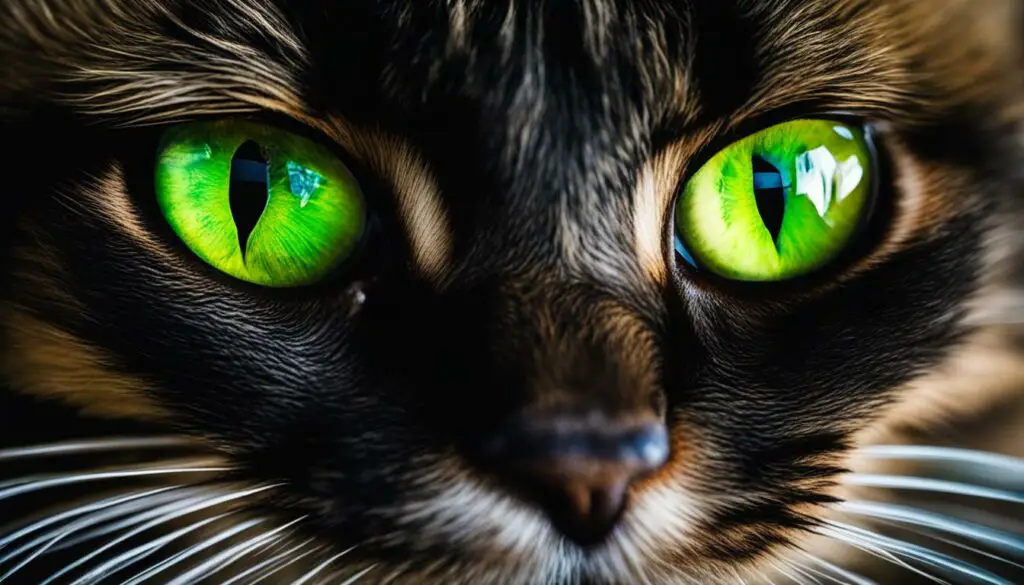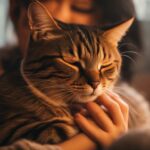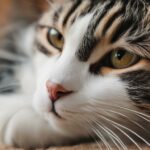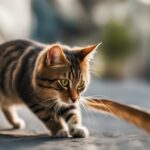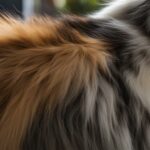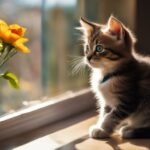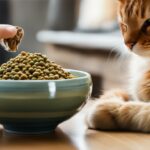Have you ever wondered why your cat seems to be fixated on your eyes? I have delved into the fascinating world of cat behavior to bring you some insights into this peculiar feline fascination. Cats have a unique way of communicating their love and affection, and their obsession with our eyes is just one of the many intriguing behaviors they display.
When your cat stares deeply into your eyes, it’s not because they’re plotting something mischievous or trying to hypnotize you. In fact, it’s a sign of trust and adoration. Cats use eye contact as a way to establish a deep connection with their human companions. Those intense gazes and slow, steady blinks are their way of saying “I love you” in their own mysterious language.
But why the eyes, you might wonder? Well, feline eyes are not only mesmerizing but also highly expressive. By focusing on your eyes, cats can gauge your emotions and intentions. It’s their way of understanding you better and strengthening the bond between you.
Key Takeaways:
- Cats fixate on our eyes as a form of communication and to establish a deeper connection.
- Direct eye contact with slow, steady blinks is a sign of trust and adoration.
- Feline eyes are highly expressive and allow cats to gauge our emotions and intentions.
The Importance of Body Language in Cat Love
Understanding cat body language is crucial in deciphering a cat’s love and affection. Cats communicate their emotions and intentions through various body signals, providing valuable insights into their feelings. By paying attention to their body language, cat owners can deepen their bond with their feline companions and ensure a harmonious relationship.
One of the most common forms of cat body language associated with love is slow blinking. When a cat looks at you and then slowly closes its eyes, it is a sign of trust and contentment. Known as a “kitty kiss,” this gesture conveys affection and reassurance. Responding with a slow blink of your own can further strengthen the connection between you and your cat.
Another important aspect of cat body language is tail language. A cat’s tail can provide valuable insights into their emotional state. An upright tail with a hooked shape signifies confidence and happiness, while a puffed-up tail indicates fear or aggression. Understanding these cues can help cat owners gauge their cat’s level of comfort and respond accordingly.
Table: Cat Tail Positions and Meanings
| Tail Position | Meaning |
|---|---|
| Upright with a Hooked Shape | Confidence and Happiness |
| Puffed-up | Fear or Aggression |
| Lashing or Wagging | Excitement or Agitation |
| Tucked between Legs | Fear or Anxiety |
In addition to tail language and slow blinking, other forms of cat body language that indicate love and affection include headbutting, rubbing against your legs, and grooming. These behaviors are a way for cats to mark you with their scent and show their ownership. By understanding and appreciating these aspects of cat body language, you can strengthen the bond with your beloved feline companion and create a loving and fulfilling relationship.
Cats and Their Eye Contact
When it comes to cat behavior, eye contact plays a significant role in communication between cats and humans. Cats use eye contact as a way to show trust and adoration towards their owners. They often make direct eye contact with lowered eyelids and slow, steady blinks, known as “kitty kisses.” These slow blinks are considered a feline version of a kiss and can be reciprocated by humans to show love back to their cats.
Eye contact is an important form of communication in the feline world. It allows cats to convey their feelings and intentions without the need for vocalizations. By making eye contact with their humans, cats are expressing their trust and comfort in the relationship. It is a way for them to connect on a deeper level and strengthen the bond between cat and owner.
Next time your cat locks eyes with you and gives you a slow blink, try responding with the same gesture. This simple act can help deepen the connection between you and your feline companion and let them know that you understand and appreciate their affection.
| Eye Contact Behavior | Meaning |
|---|---|
| Direct eye contact with slow blink | A sign of trust and affection |
| Avoiding eye contact | May indicate fear or discomfort |
| Dilated pupils and intense stare | Could signify aggression or fear |
The Significance of Headbutting
One of the unique behaviors that cats display to show their affection and love is headbutting. This social behavior is often seen as a sign of trust and adoration from a feline companion. When a cat headbutts its owner, it is marking them with its scent, claiming them as their own. This behavior is reminiscent of the way kittens interact with their mothers and littermates, rubbing their heads against them for comfort and security.
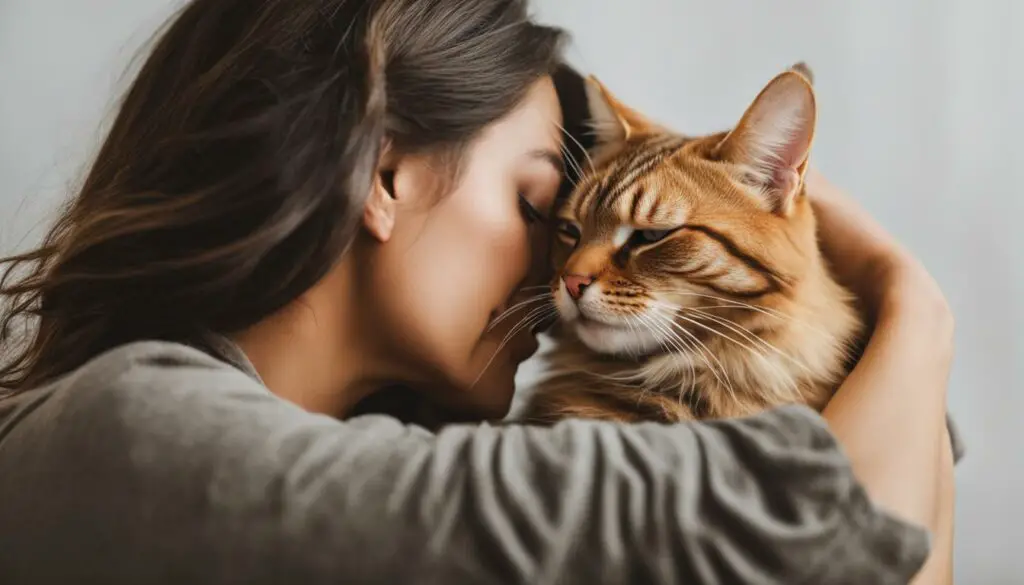
In the feline world, headbutting is a way to establish social bonds and communicate feelings of love. It is a form of non-verbal communication that cats use to show their affection and trust towards their humans. When a cat headbutts you, it is a clear indication that they feel comfortable in your presence and consider you an important part of their social group.
The Science behind Headbutting
Headbutting not only has emotional significance but also has a physiological aspect. When a cat headbutts, it releases pheromones from the scent glands located in its head. These pheromones play a role in marking territory and establishing social connections. By headbutting you, the cat is leaving its scent on you, claiming you as part of its territory and strengthening the bond between you.
| Benefits of headbutting | Significance |
|---|---|
| Establishing trust and affection | Headbutting is a way for cats to express their love and trust towards their owners. |
| Marking territory | Through headbutting, cats leave their scent on their owners, marking them as part of their social group. |
| Creating a sense of security | Headbutting provides comfort and reassurance to cats, similar to the way kittens interact with their mother. |
Next time your cat headbutts you, take it as a meaningful gesture of love and trust. Embrace this behavior and reciprocate by giving them gentle strokes and attention. By understanding the significance of headbutting, you can deepen the bond with your feline companion and create a stronger connection based on trust and affection.
The Connection Between Grooming and Bonding
One of the most intimate acts between cats is grooming. It’s a behavior that goes beyond hygiene, as it has deep emotional significance. When cats groom each other, they are not only helping to keep their fur clean but also strengthening their bond and showing affection. Interestingly, cats may extend this behavior to their human companions as well.
Grooming is a mutual activity that involves trust and vulnerability. By allowing you to groom them, cats are demonstrating their comfort and love for you. It’s their way of saying, “I trust you to care for me.” Whether it’s licking your hand, rubbing their face against your leg, or allowing you to brush their fur, grooming creates a sense of closeness and reinforces the bond between cat and human.
However, it’s important to be mindful of the cat’s body language during grooming. While some cats thoroughly enjoy being groomed, others may become overstimulated or uncomfortable. Pay attention to their cues, such as tense muscles, flattened ears, or tail flicking, which may indicate that they’ve had enough. Always respect their boundaries and provide them with a safe and positive grooming experience.
| Grooming and Bonding | Significance |
|---|---|
| Grooming each other | Strengthens bond and shows affection |
| Extending grooming to humans | Indicates trust and love |
| Grooming as a mutual activity | Creates a sense of closeness |
| Mindful of the cat’s body language | Respect boundaries and provide a positive experience |
Grooming is a beautiful way for cats to express their love and build a stronger connection with their human companions. By understanding the significance of grooming and being attentive to your cat’s needs, you can nurture a loving bond that will continue to grow over time.
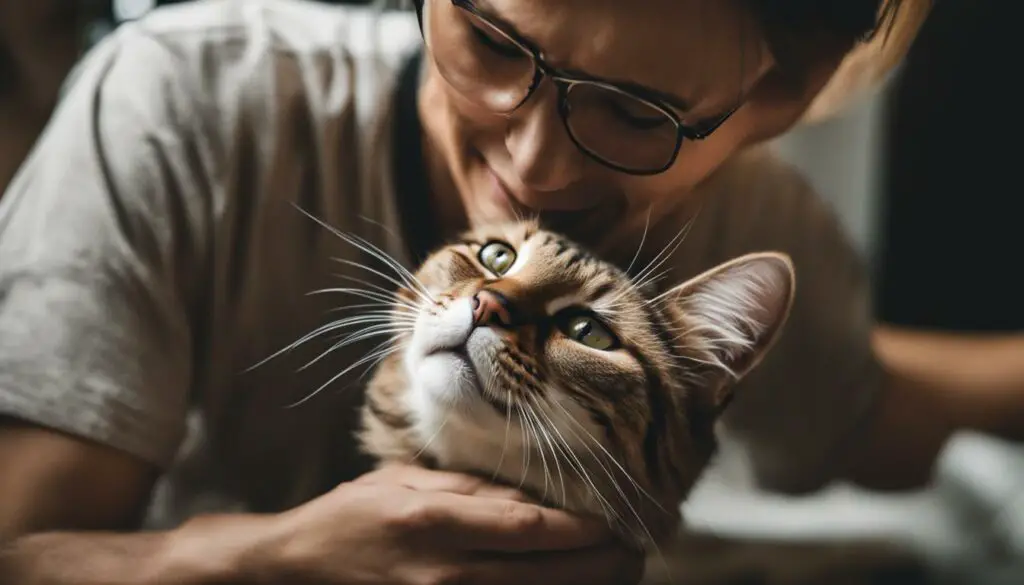
The Comfort of Kneading
Kneading is a behavior that many cat owners may have observed their furry companions engaging in. This rhythmic motion, where the cat pushes and pulls its paws against a soft surface, can be quite endearing to witness. But what exactly does kneading signify in the feline world?
Kneading is rooted in a cat’s instinctual behavior from kittenhood. When kittens nurse from their mother, they knead their paws against her mammary glands to stimulate milk flow. This action brings them comfort and nourishment. As cats grow older, they may continue to engage in kneading as a way to express contentment and relaxation.
I love watching my cat knead. It’s like she’s in her own little world of pure bliss. The rhythmic motion and the purring that accompanies it always puts a smile on my face.
When a cat kneads its owner, it is often seen as a sign of love and trust. By kneading on a human’s lap or against their body, the cat is marking its territory and claiming its owner as part of its social group. The repetitive motion, combined with the purring that often accompanies it, can have a calming and soothing effect on both the cat and its human companion.
While kneading is generally a harmless and affectionate behavior, it’s important to be mindful of your cat’s claws during the process. Some cats may inadvertently scratch their owners while kneading. Keeping your cat’s nails trimmed or providing a soft blanket or cushion for them to knead on can help prevent any accidental injuries.
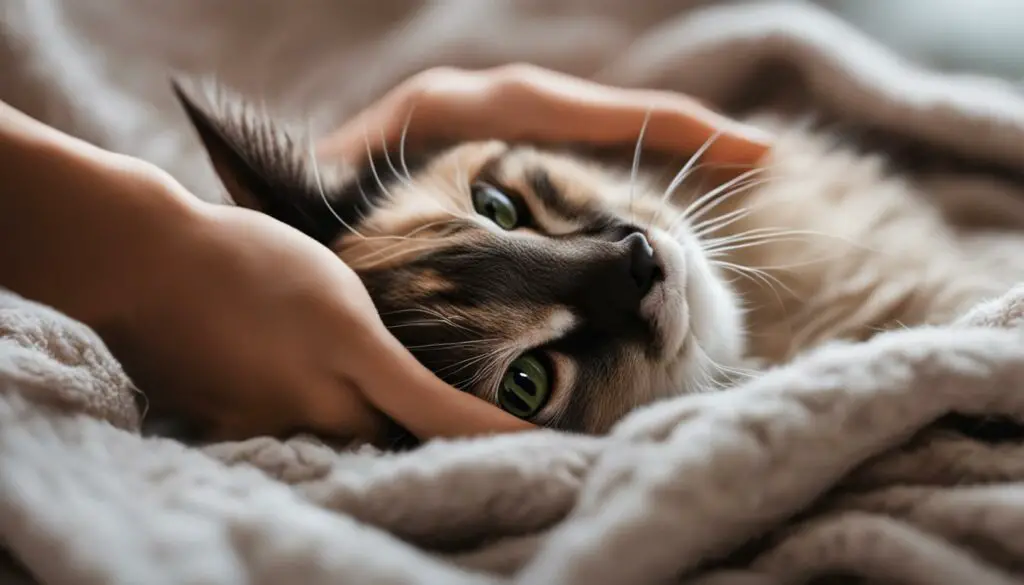
The Comfort of Kneading: A Visual Representation
| Kneading Behavior | Cat’s Emotional State |
|---|---|
| Slow, rhythmic motion of paws against a soft surface | Contentment and relaxation |
| Purring | Expressing pleasure and comfort |
| Headbutting against owner’s body | Marking territory and claiming owner as part of social group |
Understanding the comfort and significance behind kneading can help strengthen the bond between you and your feline friend. So the next time your cat starts kneading, embrace the moment and appreciate the love and trust they are expressing through this endearing behavior.
The Vulnerability of Showing the Belly
When a cat shows its belly, it is a sign of trust and relaxation. Cats only display their bellies when they feel safe and comfortable in their environment. It’s a vulnerable position for a cat, as the belly is a sensitive area that can be easily injured. So when a cat exposes its belly to you, it’s a clear indication that it feels secure and trusts you completely.
While some cats enjoy belly rubs and will invite you to give them a gentle scratch, not all cats appreciate this form of interaction. It’s important to remember that each cat is unique, and their preferences may vary. Some cats may prefer to keep their bellies protected and may react defensively if you attempt to touch them there. It’s best to observe your cat’s body language and respect their boundaries. If they solicit belly rubs, proceed with caution and offer gentle strokes to avoid overstimulation.
“When a cat shows its belly, it’s a true sign of vulnerability and trust. It’s their way of saying ‘I feel safe and comfortable in your presence.'”
Additionally, the position of a cat’s tail can provide valuable insight into their emotional state when they show their belly. If the tail is relaxed and extended, it indicates contentment and relaxation. Conversely, if the tail is puffed up or twitching, it may be a sign of arousal or agitation. Understanding these subtle cues can help you gauge your cat’s comfort level and ensure that you provide the appropriate response.
| Body Language | Meaning |
|---|---|
| Relaxed belly, extended tail | Contentment and trust |
| Puffed up tail, twitching | Arousal or agitation |
In summary, when a cat shows its belly, it is a vulnerable and intimate gesture that signifies trust and relaxation. It’s crucial to respect your cat’s boundaries and only engage in belly rubs if your cat welcomes this form of interaction. Pay attention to their body language, including the position of their tail, to ensure a positive and comfortable experience for both you and your feline companion.
The Significance of Meowing and Purring in Cat Behavior
Meowing and purring are two common forms of communication that cats use to express their feelings and needs. As cat owners, it’s important to understand the meaning behind these vocalizations and how they contribute to feline behavior patterns.
When a cat meows, it can be a way of seeking attention or communicating a specific need, such as hunger or the desire to be let outside. Short and quiet meows usually indicate contentment and trust, while longer and more drawn-out meows can signal frustration or discomfort. It’s essential to pay attention to the context and accompanying body language to decode what your cat is trying to convey.
Purring, on the other hand, is a well-known sign of a content and relaxed cat. Cats purr when they are feeling comfortable, safe, and happy. However, it’s important to note that purring can also be a way for cats to self-soothe in stressful situations or when they are in pain. It’s crucial to observe other behavioral cues and consult with a veterinarian if you have concerns about your cat’s health.
The Different Types of Meows:
- Short and quiet meows: Indicate contentment and trust.
- Long and drawn-out meows: Can signify frustration or discomfort.
- Multiple rapid meows: May indicate excitement or urgency.
Understanding your cat’s vocalizations and the context in which they occur can help strengthen the bond between you and your feline companion. By responding appropriately to their meows and purrs, you can meet their needs and ensure their well-being.
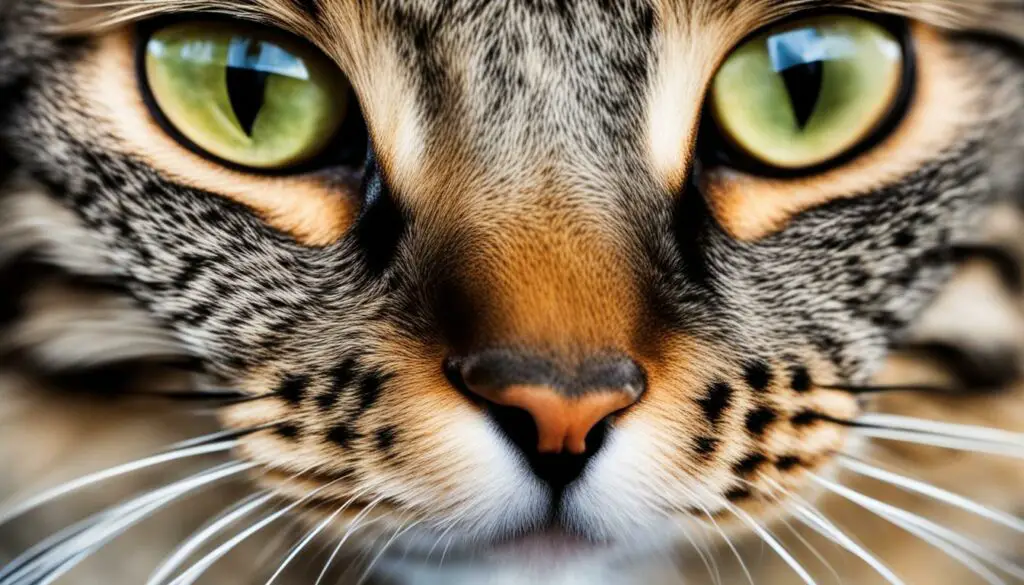
Quote:
Meowing and purring are fascinating forms of communication that cats use to express their emotions and needs. As cat owners, it’s important to listen and respond to these vocalizations, as they provide valuable insights into our furry friends’ behavior.” – Dr. Jane Foster, Feline Behavior Specialist.
Welcoming You Home with Greetings
When you come home after a long day, you may notice that your cat is eagerly waiting for you at the door. This is a heartwarming display of love and affection. Cats often greet their owners in various ways, showing their excitement and happiness at your return.
One common behavior is when your cat walks between your legs as you enter the house. This is a form of marking you as their territory, as well as a way to show their trust and adoration. Your cat may also curl their tail around your legs, which is a sign of comfort and contentment. It’s their way of saying, “I’m glad you’re back!”
“I missed you!”
Your cat may greet you with a chorus of meows, purrs, or even a little tail shake. Each cat has their own unique way of expressing their joy, but the intention is always the same – to let you know that they missed you and that they are happy to see you.
It’s important to pay attention to these greetings, as they may also indicate important needs such as hunger, thirst, or the need for a clean litter box. Take a moment to interact with your cat and give them the attention they crave. It’s through these greetings that your bond with your cat grows stronger, and you can feel the love they have for you.
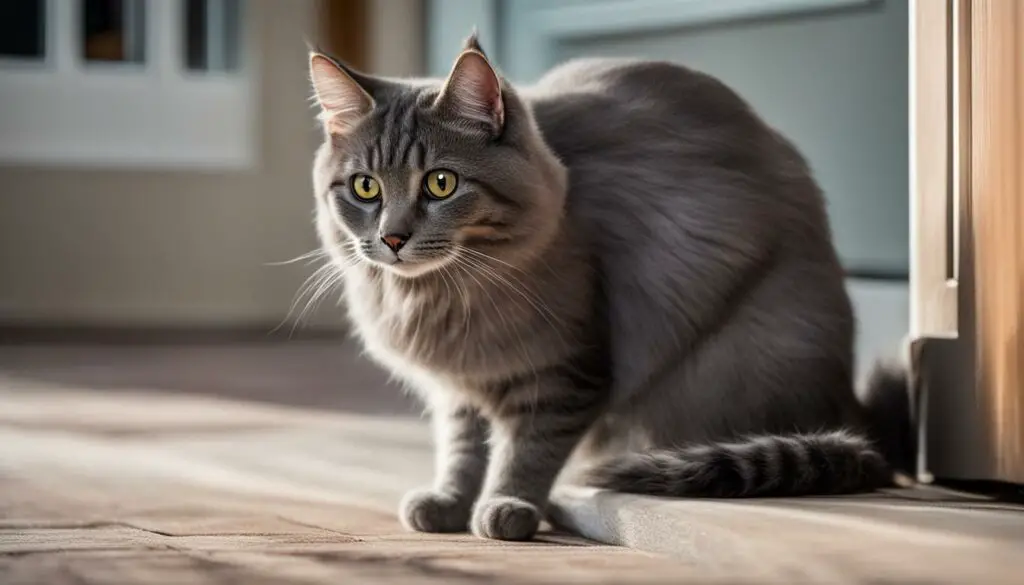
Why do cats greet their owners at the door?
Greeting their owners at the door is a natural behavior for cats, rooted in their instincts and their strong bond with their humans. Cats are social animals and form strong attachments to their owners. They see you as their source of security, food, and companionship. When you leave and then come back, it reassures them that you have not abandoned them, and they want to show their happiness at your return.
Furthermore, cats have a keen sense of smell and can detect your unique scent. They greet you at the door to rub against your legs and mark you with their own scent as a form of communication and bonding. This scent exchange helps to strengthen the bond between you and your cat.
| Greeting Behavior | Meaning |
|---|---|
| Walking between your legs | Marking you as their territory, showing trust and adoration |
| Curling their tail around your legs | Sign of comfort and contentment |
| Meowing, purring, or tail shake | Expressing joy and happiness at your return |
Your cat’s greetings are their way of saying “welcome home” and expressing their love for you. Take the time to acknowledge their greeting and shower them with affection in return. This mutual display of love and joy strengthens the bond between you and your feline companion.
The Significance of Following You
One of the ways cats show their love and attachment to their owners is by following them around. This behavior is a clear indication that your cat wants to be near you and feels safe and comfortable in your presence. When your cat follows you around the house, it is a sign of their strong bond and desire to be a part of your daily activities.
By following you, cats are also expressing a sense of trust and reliance on you as their caregiver. They see you as a source of comfort, security, and companionship. Your cat may trail behind you, staying close and keeping you in their line of sight, ensuring they never lose connection with you. This behavior is especially common in cats that have formed a deep emotional bond with their owners.
To further understand the significance of this behavior, it is important to consider a cat’s natural instincts. Cats are solitary hunters by nature, but they are also social animals that form strong social bonds. By following you, your cat is mimicking the hunting behavior of their ancestors, who would stalk, hunt, and travel in groups. Your cat’s instinctual need to be with you reinforces their feelings of love and affection.
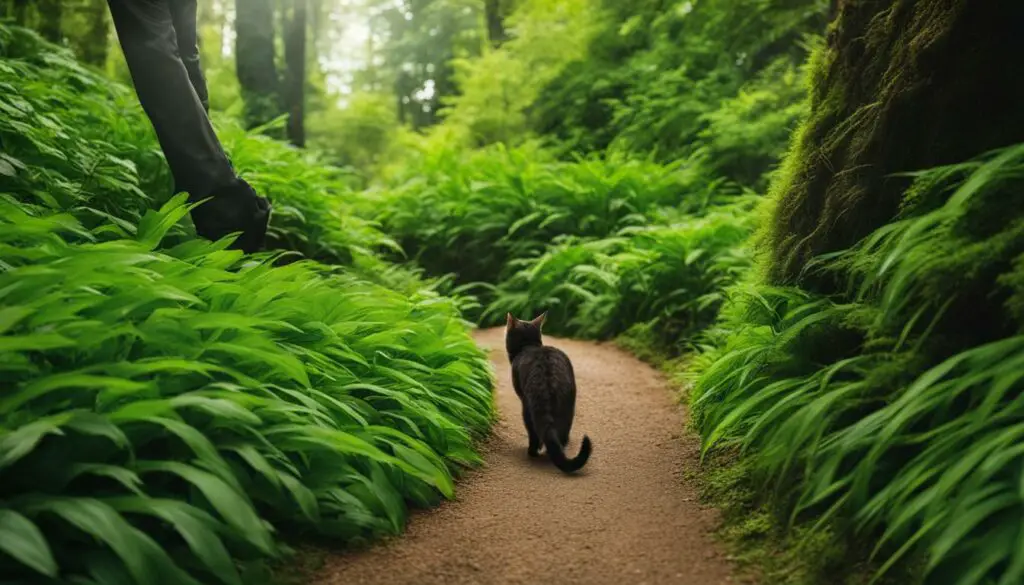
The Benefits of Your Cat Following You
Having a cat that follows you around can be a rewarding experience for both you and your feline companion. It allows for increased bonding and strengthens the emotional connection between you and your cat. Your cat’s presence is comforting and can provide a sense of companionship throughout your daily activities.
Cats that follow their owners are often more sociable and interactive, as they have a strong desire to be near their human companions. They may seek physical affection, such as rubbing against your legs or curling up next to you, further solidifying the bond between you. This behavior also provides opportunities for play and engagement, as your cat may be more inclined to join in on your activities or initiate interactive play sessions.
It’s important to cherish and respect your cat’s desire to follow you, as it is a testament to the love and trust they have for you. Ensure that your home environment is safe and comfortable for your cat, providing them with plenty of stimulation, enrichment, and opportunities for social interaction. By nurturing your cat’s need for companionship and following, you can create a harmonious and fulfilling relationship with your beloved feline friend.
Tail Language and Adoration
When it comes to cat behavior and feline
behavior patterns, tail language plays a significant role in expressing love and adoration. Understanding the various tail movements can provide valuable insights into a cat’s emotions and level of affection towards their owners.A cat with an upright tail, forming a “C” or hook shape at the top, is a clear indication of contentment and happiness. This position signifies that the cat feels safe, secure, and deeply connected with their human companion. The tail may also gently wag back and forth, which further emphasizes their relaxed state. When a cat allows their tail to touch their owner while lying next to them, it’s a beautiful display of trust and love.
It’s important to note that tail language can vary among individual cats. Some cats may exhibit different tail movements, such as a more rigid or fluffy tail, depending on their unique personalities and experiences. Observing your cat’s tail language in different contexts can help you better understand their feelings and strengthen your bond.
| Tail Position | Meaning |
|---|---|
| Upright with a hook at the top | Contentment and adoration |
| Gently wagging back and forth | Relaxed and at ease |
| Rigid or puffed up | Possible sign of fear or aggression |
In addition to tail movements, it’s essential to consider other body language cues when interpreting a cat’s affectionate behavior. The position of their ears, eyes, and overall body posture can provide valuable context to their feelings. For example, relaxed and forward-facing ears, along with half-closed eyes and a loose body, indicate a cat’s genuine adoration for their owner. On the other hand, a tense body, flattened ears, and dilated pupils may suggest discomfort or fear.
Key Takeaways:
- Tail language is a crucial aspect of cat behavior and communication.
- An upright tail with a hook shape at the top signifies contentment and adoration.
- Tail movements, such as gentle wagging, further emphasize a cat’s relaxed state.
- Each cat has unique tail language, so it’s important to observe and understand your cat’s individual expressions of love.
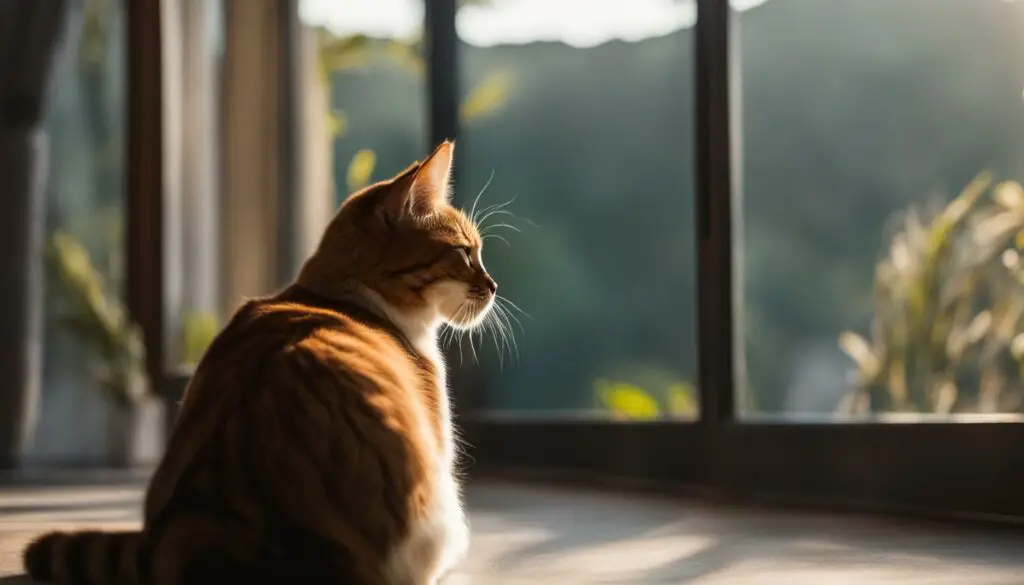
Presents as Tokens of Love
One of the ways cats show their love for their owners is by bringing them presents, and while it may not always be the most desirable gift, it is a sign of affection and pride. Cats are natural hunters, and when they bring their owners dead rodents or birds, they see it as a token of their love and appreciation. These presents are seen as a way for cats to include their owners in their feline family and to share their success in hunting.
This behavior stems from a cat’s instinctual hunting and nurturing behavior. By bringing their owners these presents, cats are not only showcasing their hunting prowess but also expressing their trust and love. As their owners provide for them and care for them, cats feel the need to reciprocate and share their “prey” as a form of gratitude. This behavior is particularly common in outdoor cats who have more opportunities to hunt and bring back gifts.
“While it may seem strange or even unpleasant to receive such presents, it’s important to understand that it’s a genuine display of love from your cat. It’s their way of showing you that they care and see you as part of their family,” explains feline behavior expert Dr. Emily Thompson.
For indoor cats who have limited hunting opportunities, they may still participate in this behavior by bringing their owners toys or other objects. While not as instinctual as hunting live prey, this gesture is also a sign of affection and a desire to share their joy with their owners. It’s important to remember that these presents are a way for cats to express their love, and while it may not always be the most pleasant gift, it’s important to appreciate the sentiment behind it.
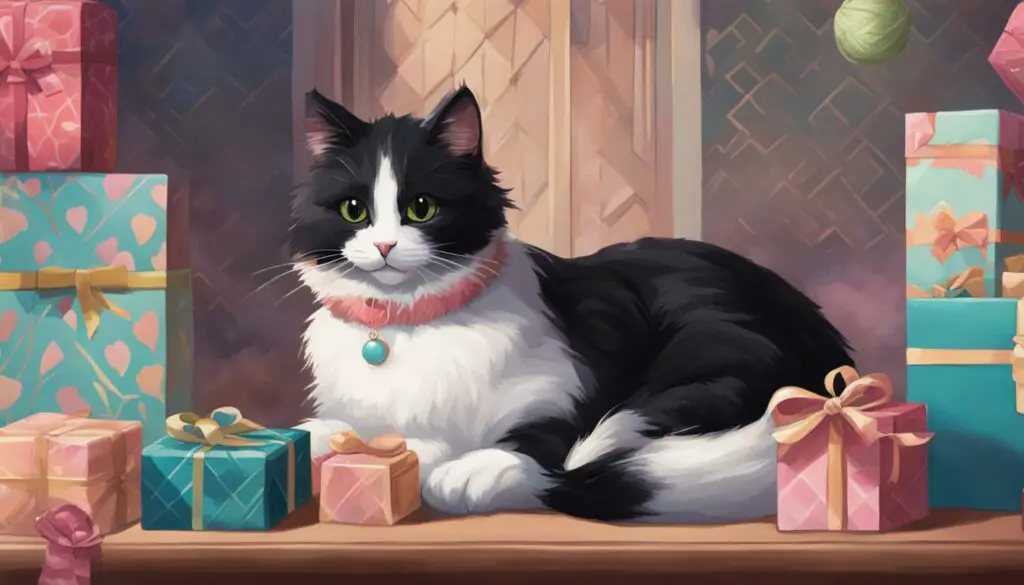
Table: Comparison of Outdoor and Indoor Cats’ Presents
| Outdoor Cats | Indoor Cats | |
|---|---|---|
| Types of Presents | Dead rodents, birds, insects | Toys, objects |
| Frequency | More frequent | Less frequent |
| Intent | Sharing hunting success, expressing love | Expressing love, sharing joy |
Conclusion
Understanding cat behavior and feline behavior patterns is key to strengthening the bond with your furry friend. Cats express their love in unique ways, from slow blinking and headbutting to grooming and kneading. By paying attention to their body language, such as tail position and eye contact, you can decode their affectionate messages.
Meowing and purring are vocalizations that cats use to communicate their emotions, while greetings at the door and following you around the house show their desire for your company. Cats may also present you with gifts as a token of their love and pride.
Remember, each cat has its own preferences and boundaries, so it’s important to respect their individuality. By nurturing your bond with patience and understanding, you can enjoy a loving and fulfilling relationship with your feline companion. So, embrace their unique behaviors and let love lead the way!
FAQ
Why does my cat slow blink at me?
Slow blinking is a sign of trust and affection. It means your cat feels comfortable and relaxed around you.
What does it mean when a cat headbutts you?
Headbutting is a way for cats to mark their owners with their scent and show love and ownership. It’s a sign of affection and bonding.
Why does my cat groom me?
Grooming is a behavior that shows trust and love. It’s a way for your cat to bond with you and make you part of their feline family.
Why does my cat knead me?
Kneading is a behavior that stems from kittenhood and indicates contentment and trust. It’s a sign that your cat feels safe and relaxed with you.
Should I rub my cat’s belly?
Showing their belly is a sign of trust, but not all cats enjoy belly rubs. It’s best to approach with caution and respect their boundaries.
How do cats show their love through vocalizations?
Short, quiet meows indicate comfort and trust, while purring is a common sign of contentment. However, longer meows or hisses can signal that a cat needs space.
Why does my cat greet me at the door?
Greeting you at the door is a way for your cat to show their excitement and affection. It may also indicate important needs like hunger or thirst.
Why does my cat follow me around?
Cats that love and trust their owners will often follow them around to stay close and show their attachment. It’s a sign of their affection and desire to be near you.
How does a cat use its tail to express love?
A cat with an upright tail and a hooked shape at the top is usually content and happy. They may also touch their tail to you when lying next to you, showing their love.
Why does my cat bring me presents?
Bringing you presents, whether it’s a dead rodent or a toy, is a way for your cat to show love and pride. They see you as part of their feline family and want to reward you.

